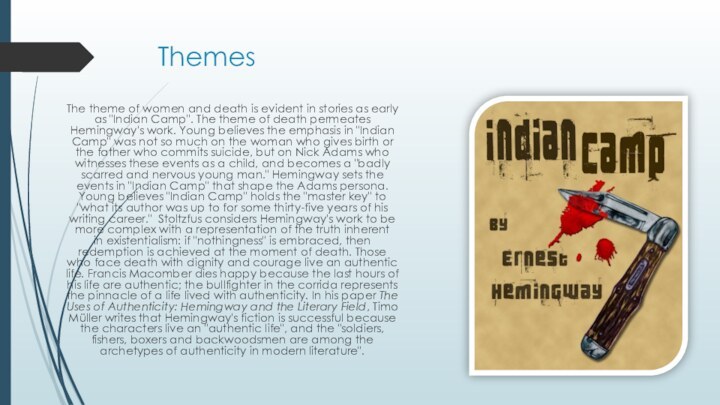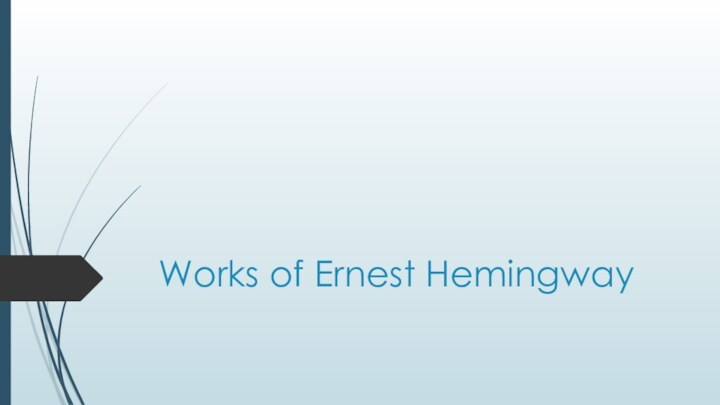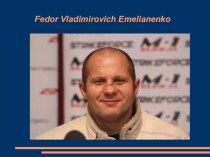Слайд 3
Writing style
The New York Times wrote in 1926 of Hemingway's
first novel, "No amount of analysis can convey the
quality of The Sun Also Rises. It is a truly gripping story, told in a lean, hard, athletic narrative prose that puts more literary English to shame." The Sun Also Rises is written in spare, tight prose that influenced countless crime and pulp fiction novels and made Hemingway famous. In 1954, when Hemingway was awarded the Nobel Prize for Literature, it was for "his mastery of the art of narrative, most recently demonstrated in The Old Man and the Sea, and for the influence that he has exerted on contemporary style." Paul Smith writes that in his first stories published In Our Time that Hemingway was still experimenting with his writing style, he avoided complicated syntax and about 70 percent of the sentences are simple sentences—a childlike syntax without subordination.
Слайд 4
Writing style
Henry Louis Gates believes Hemingway's style was fundamentally
shaped "in reaction to [his] experience of world war".
After World War I, he and other modernists "lost faith in the central institutions of Western civilization," by reacting against the elaborate style of 19th century writers and by creating a style "in which meaning is established through dialogue, through action, and silences—a fiction in which nothing crucial—or at least very little—is stated explicitly."
Слайд 5
Writing style
In his literature, and in his personal
writing, Hemingway habitually used the word "and" in place
of commas. This use of polysyndeton may serve to convey immediacy. Hemingway's polysyndetonic sentence—or in later works his use of subordinate clauses—uses conjunctions to juxtapose startling visions and images; Jackson Benson compares them to haikus. Many of Hemingway's followers misinterpreted his lead and frowned upon all expression of emotion; Saul Bellow satirized this style as "Do you have emotions? Strangle them." However, Hemingway's intent was not to eliminate emotion, but to portray it more scientifically.
Слайд 7
Themes
The popularity of Hemingway's work to a great

extent is based on the themes, which according to
scholar Frederic Svoboda are love, war, wilderness and loss, all of which are strongly evident in the body of work. These are recurring themes of American literature, which are clearly evident in Hemingway's work. Critic Leslie Fiedler sees the theme he defines as "The Sacred Land"—the American West—extended in Hemingway's work to include mountains in Spain, Switzerland and Africa, and to the streams of Michigan. The American West is given a symbolic nod with the naming of the "Hotel Montana" in The Sun Also Rises and For Whom the Bell Tolls. According to Stoltzfus and Fiedler, Hemingway's nature is a place for rebirth, for therapy, and the hunter or fisherman has a moment of transcendence when the prey is killed. Nature is where men are without women: men fish; men hunt; men find redemption in nature. Although Hemingway writes about sports, Carlos Baker believes the emphasis is more on the athlete than the sport, while Beegel sees the essence of Hemingway as an American naturalist, as reflected in such detailed descriptions as can be found in "Big Two-Hearted River".
Слайд 8
Themes
The theme of women and death is evident

in stories as early as "Indian Camp". The theme
of death permeates Hemingway's work. Young believes the emphasis in "Indian Camp" was not so much on the woman who gives birth or the father who commits suicide, but on Nick Adams who witnesses these events as a child, and becomes a "badly scarred and nervous young man." Hemingway sets the events in "Indian Camp" that shape the Adams persona. Young believes "Indian Camp" holds the "master key" to "what its author was up to for some thirty-five years of his writing career." Stoltzfus considers Hemingway's work to be more complex with a representation of the truth inherent in existentialism: if "nothingness" is embraced, then redemption is achieved at the moment of death. Those who face death with dignity and courage live an authentic life. Francis Macomber dies happy because the last hours of his life are authentic; the bullfighter in the corrida represents the pinnacle of a life lived with authenticity. In his paper The Uses of Authenticity: Hemingway and the Literary Field, Timo Müller writes that Hemingway's fiction is successful because the characters live an "authentic life", and the "soldiers, fishers, boxers and backwoodsmen are among the archetypes of authenticity in modern literature".
Слайд 10
Influence and legacy
Hemingway's legacy to American literature is
his style: writers who came after him emulated it
or avoided it. After his reputation was established with the publication of The Sun Also Rises, he became the spokesperson for the post–World War I generation, having established a style to follow. His books were burned in Berlin in 1933, "as being a monument of modern decadence". His parents disavowed his literature as "filth". Reynolds asserts the legacy is that "he left stories and novels so starkly moving that some have become part of our cultural heritage". In a 2004 speech at the John F. Kennedy Library, Russell Banks declared that he, like many male writers of his generation, was influenced by Hemingway's writing philosophy, style, and public image.








































